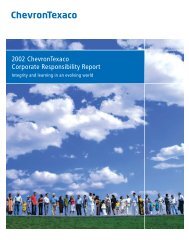Energizing California - Chevron
Energizing California - Chevron
Energizing California - Chevron
You also want an ePaper? Increase the reach of your titles
YUMPU automatically turns print PDFs into web optimized ePapers that Google loves.
<strong>Energizing</strong> <strong>California</strong><br />
Milken Institute<br />
Executive Summary<br />
<strong>California</strong> is facing a host of economic challenges. While the state remains a leader in technology and innovation,<br />
long-term factors such as aging infrastructure and the high cost of doing business have eroded its competitive<br />
advantage. Today, the declining housing market and related job losses in construction and mortgage finance<br />
have placed the state in a worrisome fiscal position. <strong>California</strong> is confronting the prospect of a more severe<br />
downturn than the nation as a whole is predicted to experience.<br />
Energy, however, is one of the bright spots in an otherwise dreary economic prognosis. The energy sector<br />
has been a stabilizing factor in the state’s economy, stimulating increased investment in oil and natural gas<br />
exploration, production, and refining, and pursuing alternative and renewable energy solutions with new<br />
urgency. As the United States looks to meet its growing energy needs while working toward sustainability and<br />
security, many innovative <strong>California</strong> firms, both small and large, are emerging as key players in shaping America’s<br />
energy future.<br />
<strong>Chevron</strong>, as a homegrown <strong>California</strong> firm—the largest in the state in terms of revenue, and the only major<br />
energy producer actually headquartered here—is uniquely positioned to influence the state’s course. While the<br />
company maintains its core business of oil and natural gas, it has also expanded its operations in fields such as<br />
unconventional hydrocarbons, alternative and renewable energy, and energy efficiency.<br />
This report aims to quantify the role played by the energy industry as a whole, and <strong>Chevron</strong> in particular,<br />
in <strong>California</strong>’s current economy, with an eye toward the state’s long-range prospects for leadership in the<br />
energy field.<br />
• In 2007, <strong>Chevron</strong> employed 10,000 workers, who contributed earnings of $1.2 billion and output<br />
of $4.5 billion to <strong>California</strong>’s economy.<br />
• The figures above represent only part of the story. After incorporating all the multiplier impacts<br />
of the supply chain and consumption, <strong>Chevron</strong>’s presence in <strong>California</strong> directly and indirectly<br />
generated a total of 68,700 jobs, $3.9 billion in earnings, and $9.2 billion in output in 2007.<br />
• The energy industry as a whole employs 65,000 people in <strong>California</strong>, with a total ripple impact<br />
of 304,500 jobs, $16.3 billion in earnings, and $46.3 billion in output.<br />
• As of 2007, the Bay Area was home to 7,100 <strong>Chevron</strong> employees, while Bakersfield had more<br />
than 1,100 and Los Angeles was home to 1,460. The ripple effects further extend their impacts.<br />
Industry Profile and Economic Impacts<br />
For comparative purposes in this report, we have defined the energy sector as the eleven industry categories<br />
(based on the North American Industry Classification System codes) in which <strong>Chevron</strong> operates, mainly relating<br />
to the production, manufacturing, exploration, transportation, and marketing of oil and natural gas. For the<br />
purposes of this study, we do not include power generation as a part of the energy sector. By adhering to the<br />
NAICS codes that define <strong>Chevron</strong>’s <strong>California</strong> operations, we have created a strict apples-to-apples comparison<br />
1

















